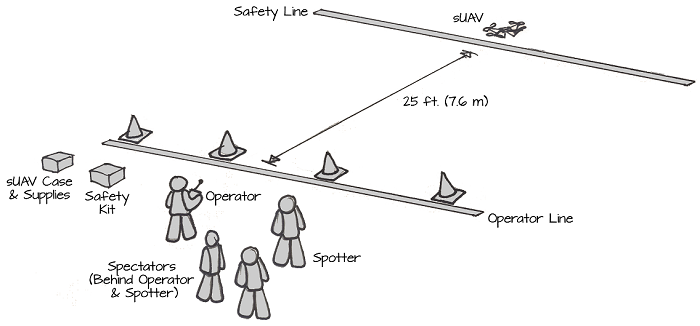

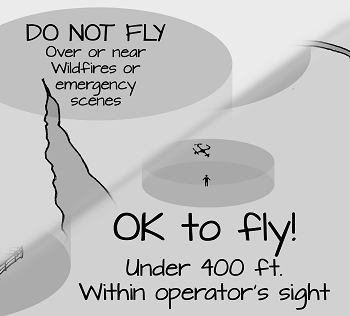
Small Unmanned Aerial Systems/Vehicles (sUAS or sUAV for short), sometimes referred to as “drones,” are extremely fun. However, they have the potential to do a lot of damage if they are not used properly. Drones—small sUAVs/sUASs/Quadcopters/Hexacopters—are hobby aircraft.
For many years, building and flying model aircraft was a hobby that only the most dedicated and skilled hobbyists got into, because it was expensive and the aircraft required a lot of skill to build and to fly. So, relatively few people built and flew model aircraft, though they learned a lot about how aircraft work and about general aviation along the way. Serious accidents were rare and most model aircraft weren’t capable enough to do a lot of damage.
Recently, technology has improved and the cost of components has come down to a point where many more people can afford to buy a small model aircraft or sUAV. In the United States alone, there were an estimated 1 million sUAVs on the day this was published. Almost anyone can go buy a “drone,” take it outside, and fly it.
It’s time for all sUAV operators to educate themselves about safety and good “drone citizenship.” The behavior of sUAV operators across the country impacts the perception of this hobby and this industry, and by extension impacts future regulations and therefore your future freedoms and responsibilities as a UAV operator. This guide provides general outlines, and points you to authoritative resources.
If you have an ELEV-8 Quadcopter you must register it with the Federal Aviation Administration’s UAS Registry before flying outdoors.
As of the date this was published, all model aircraft weighing more than 0.55 pounds (250 grams) in the United States must be registered before they can be flown outdoors. This category includes the Parallax ELEV-8 Quadcopter. Registration costs $5.00 per person and is valid for 3 years. The fee is per person, and one person may fly as many sUAV/model aircraft as they own.
This federal registration program was very new as of the date this was published, and onging adjustments and clarifications are anticipated. You are responsible for educating yourself and staying up-to-date with the latest regulations, which can be found at the link below.
Register your sUAV with the Federal Aviation Administration’s UAS Registry here before flying outdoors.
Nearly all motorized craft – including cars, motorcycles, boats, and airplanes are registered in some manner because they can all do harm or cause injury if they are not used properly and safely. sUAVs are no exception. Even small sUAVs can seriously injure someone if they are not flown responsibly.
Once you have registered, you will receive a registration number that must be put on your sUAV. It must be visible and affixed where can be accessed without using any tools (inside of a battery compartment that slides off is okay). If you are under 13, a responsible adult must register AND be with you any time that you are flying.
DO NOT FLY an sUAV without registering it first!
If you drive a car or ride a bike, there are rules that you have to follow. For instance, cars have to stay in their lanes, drive on the right side of the road, limit speed, and obey signals like stoplights and stop signs. When everyone driving on the road follows those rules, crashes are avoided and people are able to get where they need to go safely.
The National Airspace System (NAS) has a set of rules too. Without rules, airplanes could collide in the air or on the ground. Airplanes follow a set of rules to fly safely through the sky just like cars follow rules to drive safely on the road. Both are serious and must be followed.
In the United States, each of the 50 states generally regulates travel on its roadways, though all have the same general rules with only minor variations. In the US, the National Airspace System is regulated by the Federal Aviation Administration (FAA), and all aircraft follow the same rules throughout the country. The National Airspace System has designated places for model aircraft to fly. The FAA has also partnered with organizations such as the Academy of Model Aeronautics and the Association for Unmanned Vehicle Systems International to create KnowBeforeYouFly.org. Always refer to this site if there is a rule you are unsure of.
It is important to remember that the National Airspace System is 3-dimensional. Unlike roads and paths on the ground, there is a vertical component to airspace that is important to remember. It is possible to begin flying in airspace that is okay for model aircraft, and then continue that flight right into airspace that is not okay for model aircraft! The picture below shows examples of restricted and prohibited airspace—places where it is NOT okay to fly an sUAV:
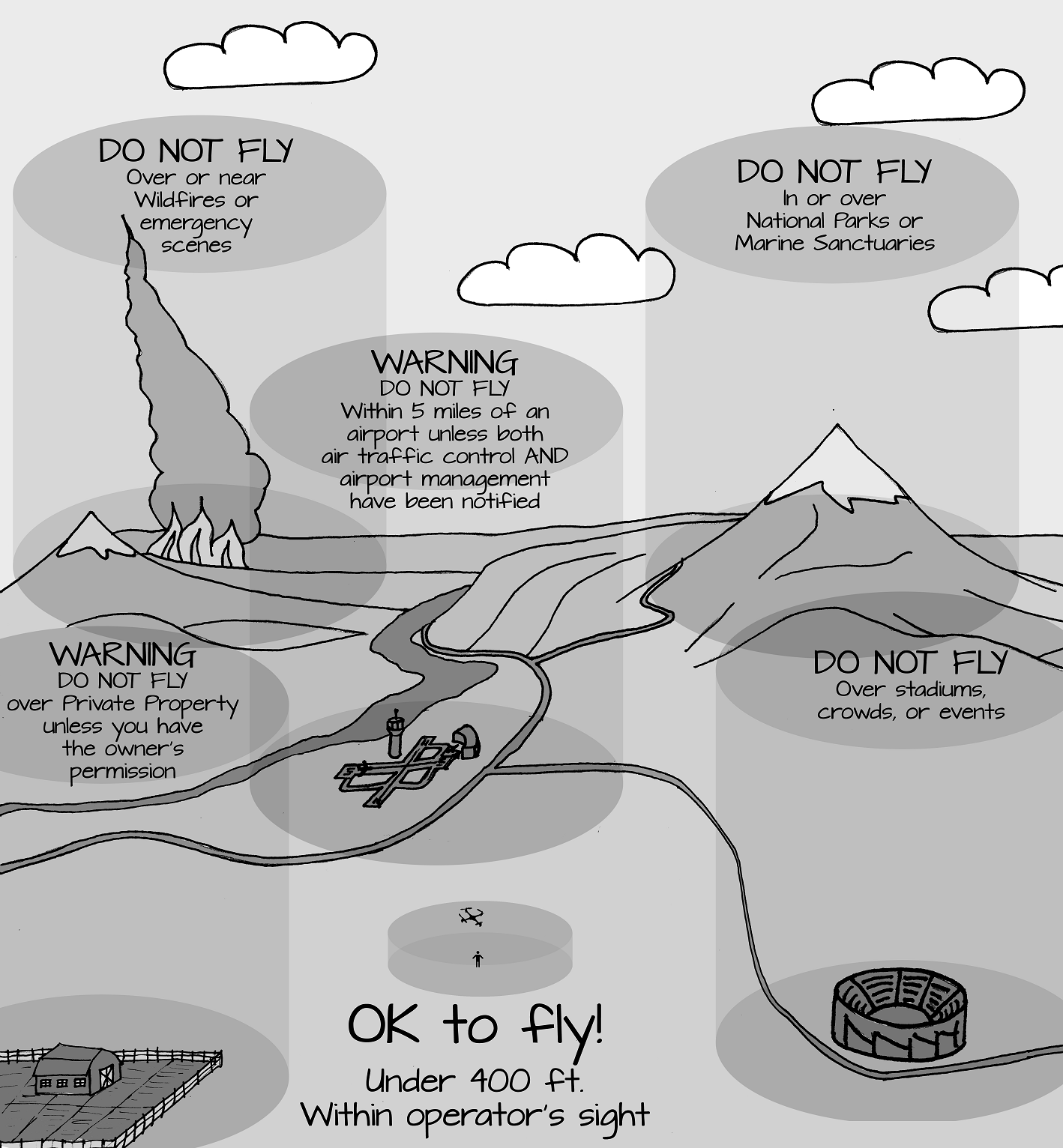
Did you know that bird-strikes cause emergency landings and damage to aircraft every year? How much more damage do you think an sUAV and explodable battery can do? Aircraft carrying people and any large aircraft ALWAYS have the right-of-way. Because airports have a lot of aircraft flying in and out of them, it is generally NOT a good idea to fly an sUAV within 5 miles of an airport. It is only okay to fly an sUAV within 5 miles of an airport if you contact the airport’s control tower AND the airport’s management to coordinate your flight plans with them. The airport will ask you a number of questions including your location, what type of craft you are flying, and what times you will be flying. They may inform you that you cannot fly where you initially plan to because of larger aircraft that have the right-of-way.
sUAVs can cause a hazard to emergency aircraft, such as medivac helicopters or fire-fighting planes, making a bad situation even worse for emergency personnel. If there is smoke in the area, the operator may lose contact with the sUAV and cause yet another emergency. Though you might be tempted to fly your hobby sUAV with a camera near an emergency to get a better view of what is going on, this is usually NOT good “drone citizenship.”
Should an sUAV malfunction, there is a higher likelihood of a person being injured when many people are concentrated into a given area. Also, professionally-flown aircraft are often present to perform at or monitor events, and hobby sUAVs pose a collision hazard for these pilots. So, don’t fly there, though again it might be tempting.
Unfortunately, crashes do happen. In wild places and remote areas, retrieving a downed sUAV could be difficult or dangerous, as would fighting a fire started by a damaged lithium polymer battery. In addition, sUAVs may frighten wildlife; many species are legally protected from harassment.
You cannot fly over private property without the owner’s permission. This includes homes and farms, and places that may not seem like private property such as shopping centers and parking lots. Not only do you need owner permission, but if you crash on someone else’s property, going onto their property to retrieve your drone without permission is trespassing.
Take a look at the picture above again. Did you notice that the restricted airspace starts at ground level and keeps going up, but the approved airspace for sUAV operators starts at ground level but stops at 400 feet above ground? This helps to keep sUAVs out of the way of professional aircraft that may be in the area.
The 400 foot limit is important to follow; large aircraft are expected to fly above 500 feet unless they are taking off and landing. There are several important exceptions: Farm aircraft (spray planes) and emergency aircraft such as medivac helicopters or fire-fighting airplanes are allowed to operate at ANY level above the ground. Because it is always possible for a large aircraft to be nearby and flying in the same airspace as your sUAV, it is important to continually look and listen for other aircraft. If you hear or see another aircraft, land your sUAV immediately and wait until you are sure the airspace is clear again.
Resources are available for sUAV operators to help them understand where they can and cannot fly. KnowBeforeYouFly.org has an interactive map that highlights restricted and prohibited airspace:
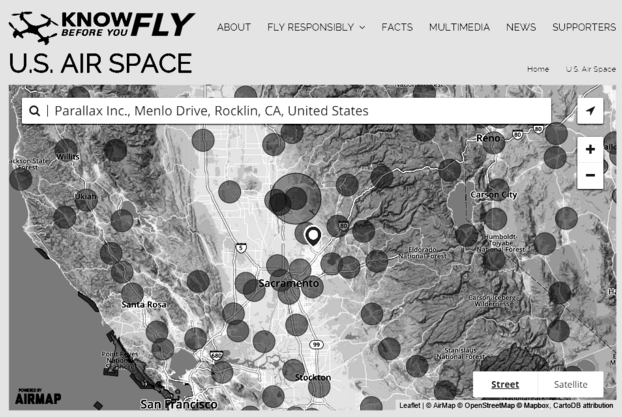
The FAA also designed an app for your mobile phone that allows you to check whether or not you can fly at your current location. Check out the B4UFLY app for more information.
In addition to the FAA, there other governmental and private entities at different levels that may seek to regulate the use of sUAVs. For you locally, this could include your state, county, or city government, cities, private property owners, and perhaps even homeowner’s associations. It is your responsibility to research any possible local regulations regarding sUAV operation in your area.
Furthermore, regulations are often subject to change. And, it is possible that some entities might seek to create and enforce regulations that are at odds with each other. It’s presently a dynamic situation, and it is a very interesting time to observe and even participate in the conversation as our society adapts to the use of new technologies. Several lawyers and law groups have blogs that chronicle and comment on the process; here are a few (the links are not a Parallax endorsement!) :
Parallax Inc has partnered with KnowBeforeYouFly.org to promote safe, responsible use of Unmanned Aerial Vehicles
You will need more than just your sUAV when you go out to fly. You will need supplies for your sUAV and safety equipment so that you are prepared in case of an emergency.
Once you’ve built or otherwise obtained your sUAV, it is tempting to connect the battery and turn on the controller immediately. DON’T!
NEVER fly any sUAV larger than 0.55 pounds (250 grams) inside of a small room, including anywhere in your home, classroom, office or store!
Because of the way air flows near walls, ceilings, and floors, it is easy for an sUAV to get “sucked into” a surface and quickly lose control, often ending in a destructive crash. Indoor flying spaces should be carefully selected and prepared.
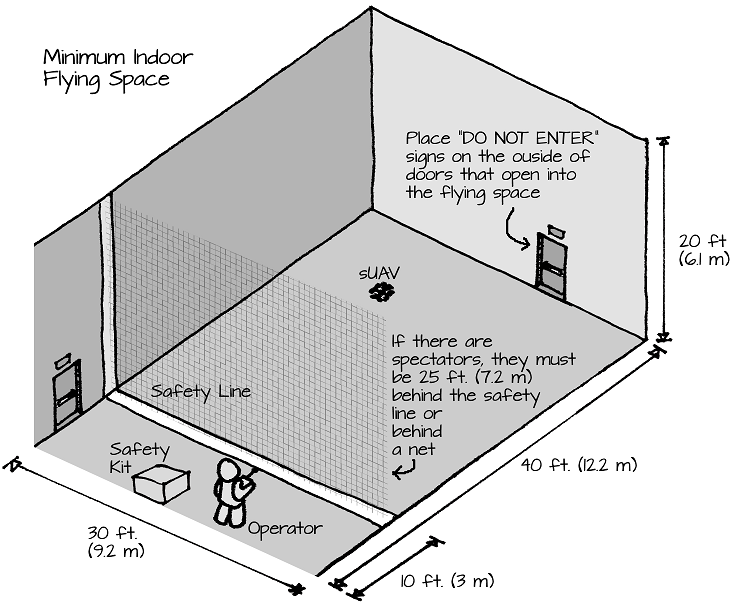
An indoor tennis court or basketball court are both large enough spaces for flying indoors. If you do not own the property you are planning to fly in, make sure the property owner understands the risks and potential damage that could be caused by an sUAV flying in their space.
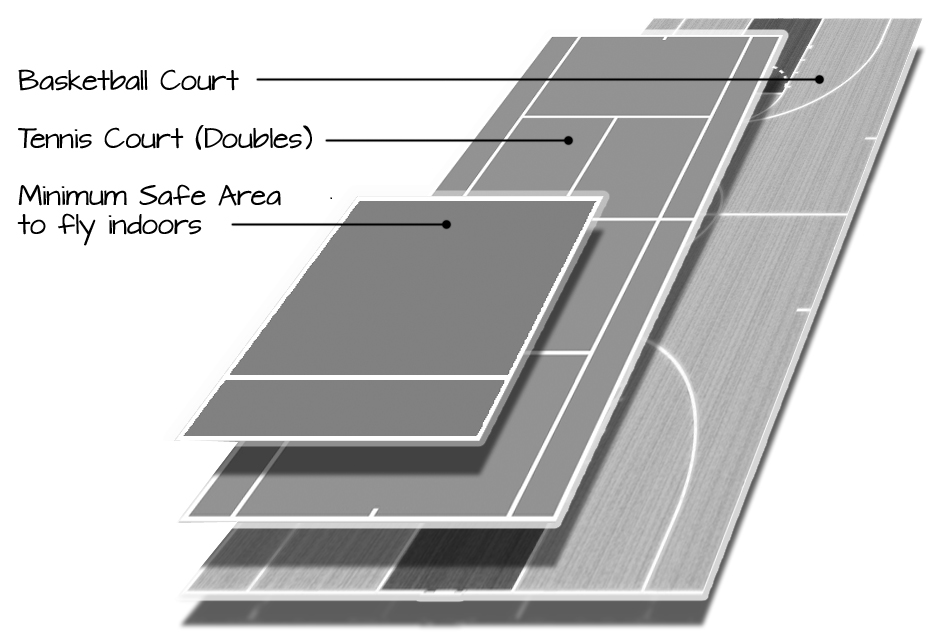
Flying outdoors provides you with much more open space to fly, but it also comes with a number of variables that are harder to control. Special care must be taken to make sure that the outdoor area you are flying in is safe and that you are properly prefared to fly your sUAV. Remember that once you begin flying outdoors, you are in the National Airspace System which is controlled by the FAA. You MUST follow all laws and rules when you fly outside.
If you have an ELEV-8 Quadcopter you must register it with the Federal Aviation Administration’s UAS Registry before flying outdoors.
The flying area must be completely clear of potential hazards. These include, but are not limited to:
Grassy fields are best for beginners; in the event of a crash they will cause significantly less damage to your quad when compared to hard surfaces. Experienced flyers may use asphalt or concrete, but all users should AVOID dirt and gravel, which can turn into dangerous projectiles.
In addition to fixed hazards, there are four things you (and your spotter) should be especially mindful of. These can be referred to as The Big 4:
If you see or hear any of the Big 4 when you are flying, land your sUAV immediately. Wait for the flying area to be completely clear before returning to flight. You must follow Academy of Model Aeronautics “See and Avoid” Guidance on avoiding manned aircraft.
The weather and air conditions will impact your success, and some conditional are too dangerous to fly in.
Spotters are required if you are flying First-Person View (FPV), and recommended for Line-of-sight flying. Your Spotter should know the laws and rules for sUAV flying. The role of the spotter is to look out for potential hazards like the Big 4.
After potential hazards have been assessed and you have determined that it is safe to fly, set up an Operator Line, and a Safety Line 25 ft. (7.6 m) away from the Operator Line. All spectators must stay behind the Operator and Spotter. The Safety and Operator Lines help remind you to keep 25ft. (7.6 m) between you and an armed sUAV at all times. Be sure to bring all of your safety equipment and make sure it is readily accessible at all times.
